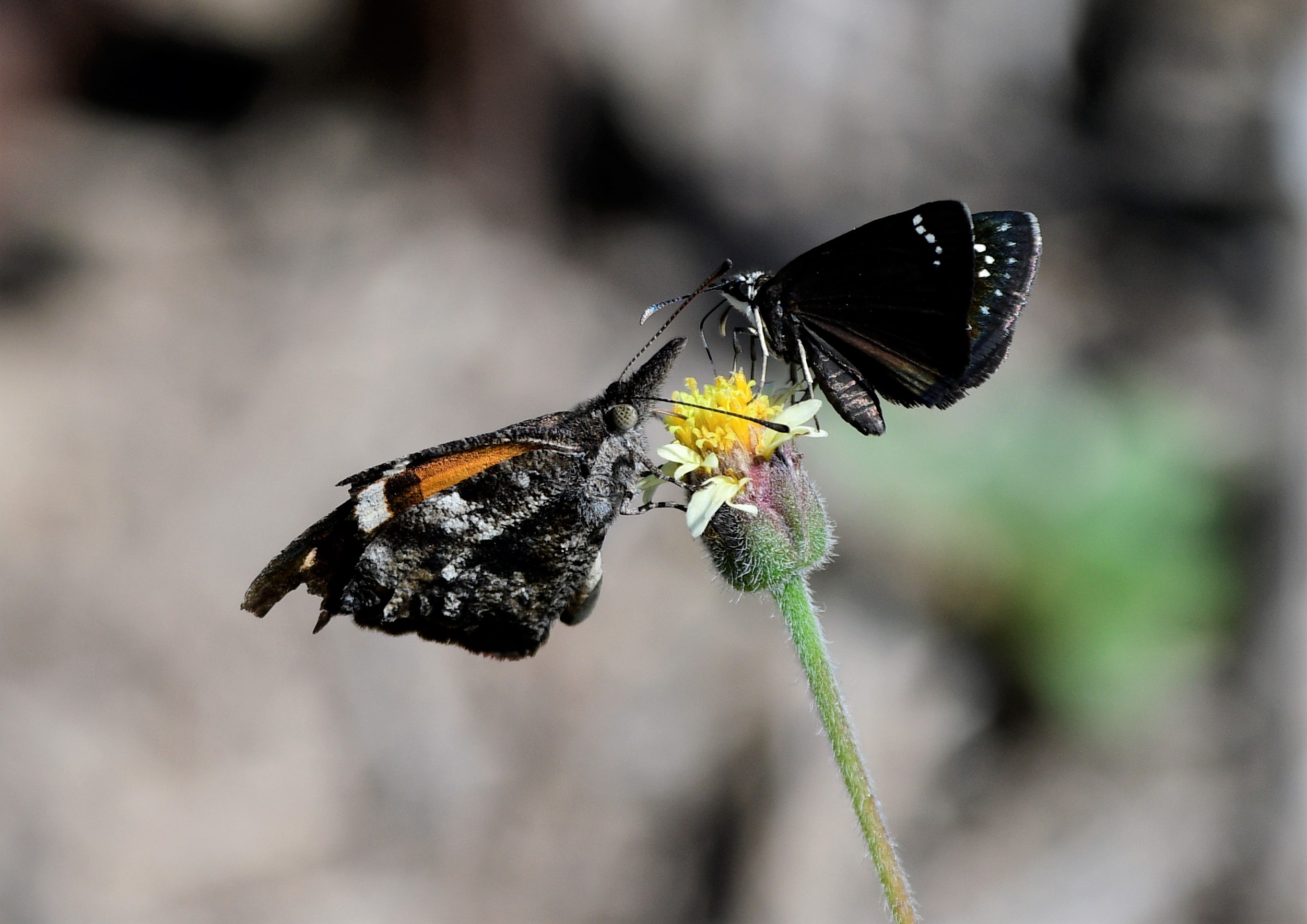
Just a quick note to say we are grateful for each of you.
Research Concludes "Summer Abundance" of Monarchs Sufficient to Buffer Winter Declines
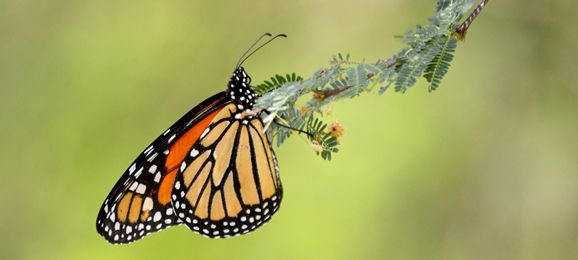
Our parent organization, the North American Butterfly Association (NABA), recently contributed to research and a white paper related to monarch population numbers. See the full report in the PDF, here, and read more below.
Monarchs are the iconic American butterfly species. Concern for the survival of this species, amidst reports of declining numbers, shrinking habitat, environmental toxins and climate change, have spurred public interest in conservation efforts to assist monarchs in their plight. For this we are grateful.
Of the 456 butterfly species tracked by NABA, there are 320 species with trends less positive that monarch butterflies. These findings are consistent with other recent analyses of large-scale insect data, documenting species decline. While we hope individuals, communities and organizations will continue to invest in monarch research, public education and habitat restoration, we encourage everyone to engage with us, their local, native plant society, or nearest NABA Chapter, to plant native for all butterfly species, which depend upon native host plants for reproduction and resilience.
PAPER ABSTRACT: Many insects are in clear decline, with monarch butterflies (Danaus plexippus) drawing particular attention as a flagship species. It is well documented that, among migratory populations, numbers of overwintering monarchs have been falling across several decades, but trends among breeding monarchs are less clear. Here, we compile 135,000 monarch observations between 1993-2018 from the North American Butterfly Association’s annual butterfly count to examine spatiotemporal patterns and potential drivers of adult monarch relative abundance trends across the entire breeding range in eastern and western North America. While the data revealed declines at some sites, particularly the US Northeast and parts of the Midwest, numbers in other areas, notably the US Southeast and Northwest, were unchanged or increasing, yielding a slightly positive overall trend across the species range. Negative impacts of agricultural glyphosate use appeared to be counterbalanced by positive effects of annual temperature, particularly in the US Midwest. Overall, our results suggest that population growth in summer is compensating for losses during the winter and that changing environmental variables have offsetting effects on mortality and/or reproduction. We suggest that density-dependent reproductive compensation when lower numbers arrive each spring is currently able to maintain relatively stable breeding monarch numbers. However, we caution against complacency since accelerating climate change may bring growing threats. Our data also suggest that increases of summer monarchs in some regions, especially in the west and far south, may reflect replacement of migratory with resident populations. Nonetheless, it is perhaps reassuring that ubiquitous downward trends in summer monarch abundance are not evident.
____________________________________________________________________________________________
Wild Bees of the National Butterfly Center
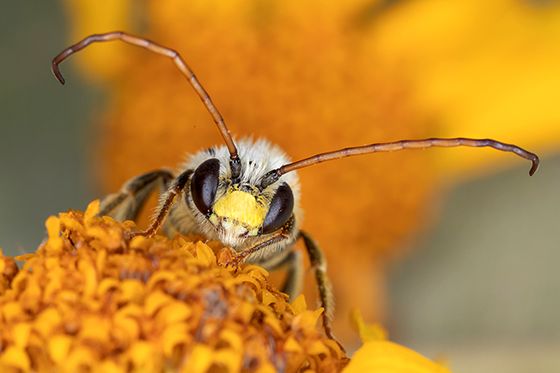
A new research project has revealed that dozens of unique and beautiful native bee species are present at the National Butterfly Center. Many of these are rarely seen within the United States, or are found here only in the Lower Rio Grande Border. One National Butterfly Center species, the red-legged Toluca leafcutter, has never been documented in this country before this year.
The NBC native bee project, conducted by distinguished photojournalists Paula Sharp and Ross Eatman, began in September 2018. Aided by scientists specializing in bees, Sharp and Eatman have now recorded more than 50 NBC native bee species in dazzling photographs, viewable on the website WILD BEES OF THE NATIONAL BUTTERFLY CENTER.
Before arriving at the National Butterfly Center, Paula Sharp and Ross Eatman undertook a three-year project documenting native bee species for New York’s state park system. Sponsored by the New York State Environmental Protection fund, this project culminated in the highly-regarded and well-traveled nature website, Wild Bees of New York, which provides information on more than 120 species of native bees of the Northeastern United States.
Sharp and Eatman’s photographs of wild bees are currently on a national tour of prominent museums, art galleries and botanical gardens. An exhibit of Sharp & Eatman’s bee photographs will be featured by the Houston Museum of Natural Science from May 24 – September 22, 2019.
Sharp and Eatman will be continuing to research and photograph bee species of the National Butterfly Center and the Lower Rio Grande Valley throughout the upcoming year.
HELP SUPPORT A NEW WILD BEE GARDEN AT THE NATIONAL BUTTERFLY CENTER!
PBS' NATURE, Sex, Lies & Butterflies from the National Butterfly Center
The National Butterfly Center, in Mission, Texas, serves as the backdrop for a portion of this insightful documentary of wild butterflies, filmed by Peabody Award-winning cinematographer Ann Johnson Prum, who recently won the Emmy for Best Cinematography in Documentary for her production of Super Hummingbirds, also for PBS' NATURE.
We were privileged and honored to host Prum and Coneflower Studios, last fall, and anxiously await the release of what promises to be a powerful and intriguing examination of the biology and behavior of butterflies that few have ever seen!
Watch the full episode here.
You never know what you'll see at the National Butterfly Center!
Did you know nearly 150 species of North American butterflies can be seen only in the Lower Rio Grande Valley (LRGV) of Texas, or by traveling to Mexico?
In fact, more than 300 species of butterflies may be found in the LRGV, and more than 200 species have been seen at the National Butterfly Center, including a number of rarities and U.S. Records!
Incredibly, almost 40% of the 700+ butterflies that can be found in the United States can be seen in this three-county area at the southernmost tip of Texas, where the subtropical climate makes it possible to enjoy the outdoors year 'round.
Peace, Love, Butterflies
Ten years ago, the North American Butterfly Association broke ground for what has now become the largest native plant botanical garden in the United States. This 100-acre preserve is home to Spike (who thinks he is a butterfly) and the greatest volume and variety of wild, free-flying butterflies in the nation. In fact, USA Today calls the National Butterfly Center, in Mission, Texas, "the butterfly capitol of the USA."

Buy your bumper sticker here.
Experience the National Butterfly Center
A flagship project of the North American Butterfly Association, the NBC is committed to 'Growing Connections' between people, plants, and the winged wonders that pollinate and propagate all that grows around us. We do this through educational and environmental initiatives that cultivate meaningful understanding of the parties and processes that create beneficial and sustainable ecosystems.
The Center showcases live animals and plants, in wild and cultivated settings, with educational exhibits to enhance human understanding and appreciation. This large-scale project is designed to ensure our beautiful landscape and the wildlife we take for granted will be here for future generations to enjoy. In addition to the ever-growing gardens and trails, the Center now boasts an impressive, new Visitor's Pavilion, designed by Wendy Evans Joseph, principal architect of the Holocaust Museum in Washington, DC, and the Women's Museum in Dallas, Texas.
Located in Mission, Texas, near the Rio Grande River, and only 15 minutes from a major airport in McAllen, The Center is open to the public, for visitors and members, seven days/week.
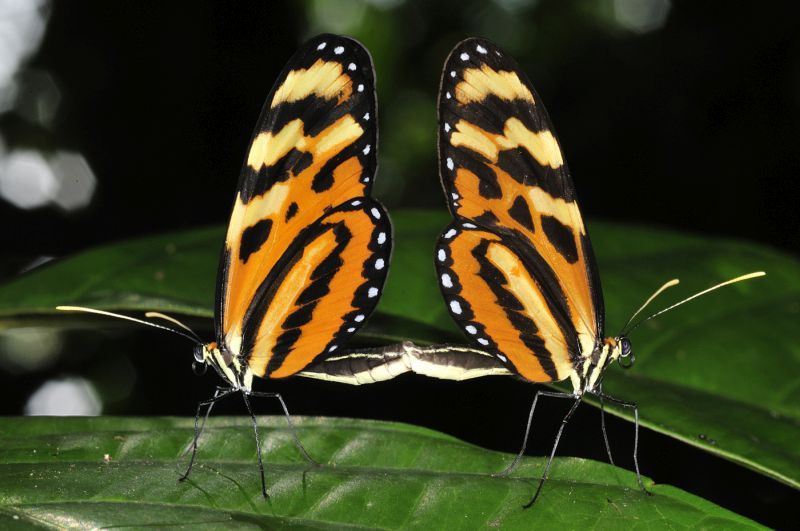
Costa Rica Butterfly Expedition - June 14 - 21, 2021 - ON HOLD
Highlights
- Experience world-renowned conservation projects, such as Santa Rosa National Park, where close to 1,500 butterfly species have been identified.
- Take guided walks and exciting hikes through gorgeous gardens and lush rainforests to enjoy the rich biodiversity and search for butterflies, birds, and other wildlife.
- Learn from one of Cost Rica’s foremost lepidopterists, Ricardo Murillo, your trip’s expert environmental educator.
LEARN MORE HERE
Biden on Blast
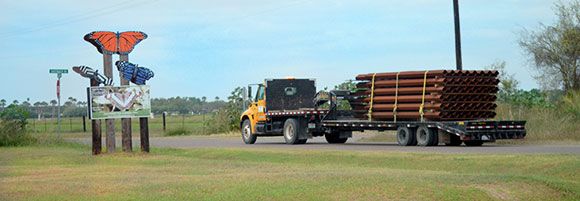
This Saturday, the New York Times published an article regarding “A Rush to Expand the Wall That Many Fear is Here to Stay.” In it, the authors state:
“Advisers involved with the transition team, who spoke on the condition of anonymity to discuss planning for the incoming administration, rejected the notion that there would be any attempt to dismantle the existing border wall, with one adviser calling the wall a “distraction.””
This point of view has been expressed by Ali Noorani of the National Immigration Forum, who previously called the wall “a distraction that frankly only the margins like to yell about.”
Well, we are hardly the margin.
People who care about the survival of species and the health of the environment, not to mention the Constitution, are NOT on the margins.
What we are is directly impacted by the decisions these policy wonks advocate for far away, inside the Washington, DC Beltway.
We are the ones who have our levees torn open during hurricane season; the ones who lose what limited greenspace remains in our communities; the who no longer enjoy the protection of laws that are waived, like the Clean Water Act and the Solid Waste Disposal Act; the ones who suffer the bulldozing of historical landmarks and sacred burial grounds; the ones who have our land condemned and confiscated.
Each day, we watch flatbed trucks with border wall panels drive by as Trump’s wall goes up on either side of the National Butterfly Center. This truckload was headed to Bentsen-Rio Grande Valley State Park where wall is being built at the park entrance, even though construction was prohibited in the 2019 Department of Homeland Security spending bill. And right now, Congress is considering a 2021 budget that actually contains almost $2 billion MORE for border wall construction!
PLEASE HELP US ELEVATE THIS ISSUE SO IT CANNOT BE IGNORED OR DISMISSED BY PRESIDENT-ELECT BIDEN AND VICE PRESIDENT-ELECT HARRIS, NO MATTER WHO THEY SURROUND THEMSELVES WITH.
Please DOWNLOAD THIS POSTCARD! Print it double-sided, cut it, stamp it, sign it and mail it—and get your friends to do it, too!
We need your help to ensure the Biden administration will NOT do as the Obama Administration did and allow his predecessor’s border wall project to continue or allow any contracts to be fulfilled.
THANK YOU!
 DOWNLOAD |
Now You Know
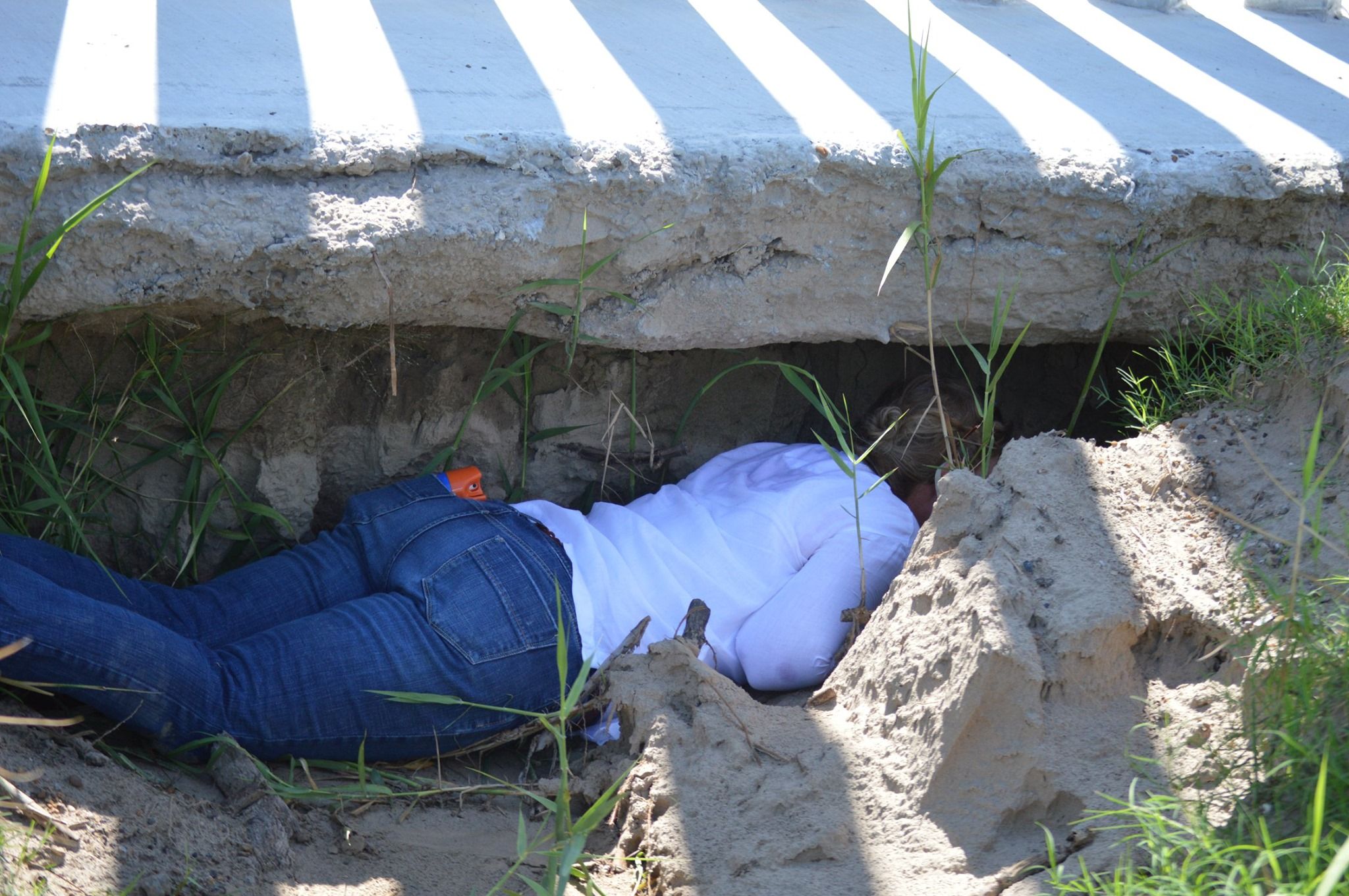
The North American Butterfly Association filed suit against Brian Kolfage/We Build the Wall, Tommy Fisher/Fisher Sand & Gravel/TRG Construction and Lance Neuhaus/Neuhaus & Sons on Dec. 3, 2019.
When 60 Minutes reached out to us many months later, they were focused on Brian Kolfage, the front man for We Build the Wall. We had to inform them about WBTW’s “Advisory Board Chairman” Steve Bannon’s role in this scheme, business partner Tommy Fisher, and the participation of multiple fake news outlets, Senator Kevin Cramer, Donald Trump, Jr.…and ultimately,Trump, Sr. as all roads led back to the White House, from which Bannon departed in August, 2017.
We’re not sure they fully understood or believed us (in spite of much reporting related to all of the above) until Kolfage, Bannon and two associates were federally-indicted for fraud and conspiracy to commit money laundering on August 20, 2020.
We appreciate CBS News and 60 Minutes, in addition to ProPublica, the Texas Tribune and other legitimate investigative news outlets for shining a spotlight on the illegal activity of these fraudsters who targeted our organization and our executive director in an orchestrated campaign to malign and maliciously defame us for their personal gain.
 Today, two of the three men pictured here have been arrested and the grand jury is still seated; so, additional indictments will likely be forthcoming. The current indictment refers to “unnamed Co-conspirator #2, a construction contractor,” among others we hope to see arrested soon.
Today, two of the three men pictured here have been arrested and the grand jury is still seated; so, additional indictments will likely be forthcoming. The current indictment refers to “unnamed Co-conspirator #2, a construction contractor,” among others we hope to see arrested soon.
Meanwhile, our lawsuit has been set for trial Sept. 7, 2021 (yes, one year from now).
Please continue to SHARE our story and join or donate to defend the National Butterfly Center’s mission, land and staff. Everything that must be done to prepare for trial, including LOADS of discovery and many depositions, is going to be costly. For this reason, we are enlisting all the aid and support we can garner to expose and punish those who seek to harm the environment and us.
As always, we will be good stewards of your gifts.
With gratitude,
The Board of Directors, Members & Staff of the North American Butterfly Association
____________________________________________________________________________________________
Wild Bees of the National Butterfly Center

A new research project has revealed that dozens of unique and beautiful native bee species are present at the National Butterfly Center. Many of these are rarely seen within the United States, or are found here only in the Lower Rio Grande Border. One National Butterfly Center species, the red-legged Toluca leafcutter, has never been documented in this country before this year.
The NBC native bee project, conducted by distinguished photojournalists Paula Sharp and Ross Eatman, began in September 2018. Aided by scientists specializing in bees, Sharp and Eatman have now recorded more than 50 NBC native bee species in dazzling photographs, viewable on the website WILD BEES OF THE NATIONAL BUTTERFLY CENTER.
Before arriving at the National Butterfly Center, Paula Sharp and Ross Eatman undertook a three-year project documenting native bee species for New York’s state park system. Sponsored by the New York State Environmental Protection fund, this project culminated in the highly-regarded and well-traveled nature website, Wild Bees of New York, which provides information on more than 120 species of native bees of the Northeastern United States.
Sharp and Eatman’s photographs of wild bees are currently on a national tour of prominent museums, art galleries and botanical gardens. An exhibit of Sharp & Eatman’s bee photographs will be featured by the Houston Museum of Natural Science from May 24 – September 22, 2019.
Sharp and Eatman will be continuing to research and photograph bee species of the National Butterfly Center and the Lower Rio Grande Valley throughout the upcoming year.
HELP SUPPORT A NEW WILD BEE GARDEN AT THE NATIONAL BUTTERFLY CENTER!
PBS' NATURE, Sex, Lies & Butterflies from the National Butterfly Center
The National Butterfly Center, in Mission, Texas, serves as the backdrop for a portion of this insightful documentary of wild butterflies, filmed by Peabody Award-winning cinematographer Ann Johnson Prum, who recently won the Emmy for Best Cinematography in Documentary for her production of Super Hummingbirds, also for PBS' NATURE.
We were privileged and honored to host Prum and Coneflower Studios, last fall, and anxiously await the release of what promises to be a powerful and intriguing examination of the biology and behavior of butterflies that few have ever seen!
Watch the full episode here.

You never know what you'll see at the National Butterfly Center!
Did you know nearly 150 species of North American butterflies can be seen only in the Lower Rio Grande Valley (LRGV) of Texas, or by traveling to Mexico?
In fact, more than 300 species of butterflies may be found in the LRGV, and more than 200 species have been seen at the National Butterfly Center, including a number of rarities and U.S. Records!
Incredibly, almost 40% of the 700+ butterflies that can be found in the United States can be seen in this three-county area at the southernmost tip of Texas, where the subtropical climate makes it possible to enjoy the outdoors year 'round.
Peace, Love, Butterflies
Ten years ago, the North American Butterfly Association broke ground for what has now become the largest native plant botanical garden in the United States. This 100-acre preserve is home to Spike (who thinks he is a butterfly) and the greatest volume and variety of wild, free-flying butterflies in the nation. In fact, USA Today calls the National Butterfly Center, in Mission, Texas, "the butterfly capitol of the USA."
Buy your bumper sticker here.
Experience the National Butterfly Center
A flagship project of the North American Butterfly Association, the NBC is committed to 'Growing Connections' between people, plants, and the winged wonders that pollinate and propagate all that grows around us. We do this through educational and environmental initiatives that cultivate meaningful understanding of the parties and processes that create beneficial and sustainable ecosystems.
The Center showcases live animals and plants, in wild and cultivated settings, with educational exhibits to enhance human understanding and appreciation. This large-scale project is designed to ensure our beautiful landscape and the wildlife we take for granted will be here for future generations to enjoy. In addition to the ever-growing gardens and trails, the Center now boasts an impressive, new Visitor's Pavilion, designed by Wendy Evans Joseph, principal architect of the Holocaust Museum in Washington, DC, and the Women's Museum in Dallas, Texas.
Located in Mission, Texas, near the Rio Grande River, and only 15 minutes from a major airport in McAllen, The Center is open to the public, for visitors and members, seven days/week.

Announcing a New Partnership for Change
Why The Butterfly?
Research Concludes "Summer Abundance" of Monarchs Sufficient to Buffer Winter Declines

Our parent organization, the North American Butterfly Association (NABA), recently contributed to research and a white paper related to monarch population numbers. See the full report in the PDF, here, and read more below.
Monarchs are the iconic American butterfly species. Concern for the survival of this species, amidst reports of declining numbers, shrinking habitat, environmental toxins and climate change, have spurred public interest in conservation efforts to assist monarchs in their plight. For this we are grateful.
Of the 456 butterfly species tracked by NABA, there are 320 species with trends less positive that monarch butterflies. These findings are consistent with other recent analyses of large-scale insect data, documenting species decline. While we hope individuals, communities and organizations will continue to invest in monarch research, public education and habitat restoration, we encourage everyone to engage with us, their local, native plant society, or nearest NABA Chapter, to plant native for all butterfly species, which depend upon native host plants for reproduction and resilience.
PAPER ABSTRACT: Many insects are in clear decline, with monarch butterflies (Danaus plexippus) drawing particular attention as a flagship species. It is well documented that, among migratory populations, numbers of overwintering monarchs have been falling across several decades, but trends among breeding monarchs are less clear. Here, we compile 135,000 monarch observations between 1993-2018 from the North American Butterfly Association’s annual butterfly count to examine spatiotemporal patterns and potential drivers of adult monarch relative abundance trends across the entire breeding range in eastern and western North America. While the data revealed declines at some sites, particularly the US Northeast and parts of the Midwest, numbers in other areas, notably the US Southeast and Northwest, were unchanged or increasing, yielding a slightly positive overall trend across the species range. Negative impacts of agricultural glyphosate use appeared to be counterbalanced by positive effects of annual temperature, particularly in the US Midwest. Overall, our results suggest that population growth in summer is compensating for losses during the winter and that changing environmental variables have offsetting effects on mortality and/or reproduction. We suggest that density-dependent reproductive compensation when lower numbers arrive each spring is currently able to maintain relatively stable breeding monarch numbers. However, we caution against complacency since accelerating climate change may bring growing threats. Our data also suggest that increases of summer monarchs in some regions, especially in the west and far south, may reflect replacement of migratory with resident populations. Nonetheless, it is perhaps reassuring that ubiquitous downward trends in summer monarch abundance are not evident.
____________________________________________________________________________________________
Wild Bees of the National Butterfly Center

A new research project has revealed that dozens of unique and beautiful native bee species are present at the National Butterfly Center. Many of these are rarely seen within the United States, or are found here only in the Lower Rio Grande Border. One National Butterfly Center species, the red-legged Toluca leafcutter, has never been documented in this country before this year.
The NBC native bee project, conducted by distinguished photojournalists Paula Sharp and Ross Eatman, began in September 2018. Aided by scientists specializing in bees, Sharp and Eatman have now recorded more than 50 NBC native bee species in dazzling photographs, viewable on the website WILD BEES OF THE NATIONAL BUTTERFLY CENTER.
Before arriving at the National Butterfly Center, Paula Sharp and Ross Eatman undertook a three-year project documenting native bee species for New York’s state park system. Sponsored by the New York State Environmental Protection fund, this project culminated in the highly-regarded and well-traveled nature website, Wild Bees of New York, which provides information on more than 120 species of native bees of the Northeastern United States.
Sharp and Eatman’s photographs of wild bees are currently on a national tour of prominent museums, art galleries and botanical gardens. An exhibit of Sharp & Eatman’s bee photographs will be featured by the Houston Museum of Natural Science from May 24 – September 22, 2019.
Sharp and Eatman will be continuing to research and photograph bee species of the National Butterfly Center and the Lower Rio Grande Valley throughout the upcoming year.
HELP SUPPORT A NEW WILD BEE GARDEN AT THE NATIONAL BUTTERFLY CENTER!
PBS' NATURE, Sex, Lies & Butterflies from the National Butterfly Center
The National Butterfly Center, in Mission, Texas, serves as the backdrop for a portion of this insightful documentary of wild butterflies, filmed by Peabody Award-winning cinematographer Ann Johnson Prum, who recently won the Emmy for Best Cinematography in Documentary for her production of Super Hummingbirds, also for PBS' NATURE.
We were privileged and honored to host Prum and Coneflower Studios, last fall, and anxiously await the release of what promises to be a powerful and intriguing examination of the biology and behavior of butterflies that few have ever seen!
Watch the full episode here.
You never know what you'll see at the National Butterfly Center!
Did you know nearly 150 species of North American butterflies can be seen only in the Lower Rio Grande Valley (LRGV) of Texas, or by traveling to Mexico?
In fact, more than 300 species of butterflies may be found in the LRGV, and more than 200 species have been seen at the National Butterfly Center, including a number of rarities and U.S. Records!
Incredibly, almost 40% of the 700+ butterflies that can be found in the United States can be seen in this three-county area at the southernmost tip of Texas, where the subtropical climate makes it possible to enjoy the outdoors year 'round.
Peace, Love, Butterflies
Ten years ago, the North American Butterfly Association broke ground for what has now become the largest native plant botanical garden in the United States. This 100-acre preserve is home to Spike (who thinks he is a butterfly) and the greatest volume and variety of wild, free-flying butterflies in the nation. In fact, USA Today calls the National Butterfly Center, in Mission, Texas, "the butterfly capitol of the USA."

Buy your bumper sticker here.
Experience the National Butterfly Center
A flagship project of the North American Butterfly Association, the NBC is committed to 'Growing Connections' between people, plants, and the winged wonders that pollinate and propagate all that grows around us. We do this through educational and environmental initiatives that cultivate meaningful understanding of the parties and processes that create beneficial and sustainable ecosystems.
The Center showcases live animals and plants, in wild and cultivated settings, with educational exhibits to enhance human understanding and appreciation. This large-scale project is designed to ensure our beautiful landscape and the wildlife we take for granted will be here for future generations to enjoy. In addition to the ever-growing gardens and trails, the Center now boasts an impressive, new Visitor's Pavilion, designed by Wendy Evans Joseph, principal architect of the Holocaust Museum in Washington, DC, and the Women's Museum in Dallas, Texas.
Located in Mission, Texas, near the Rio Grande River, and only 15 minutes from a major airport in McAllen, The Center is open to the public, for visitors and members, seven days/week.
Resources
General Links
- Butterflies and Moths of North America - Excellent resource!
- Children's Butterfly Site - Good site for kids and teachers
- Electronic Resoures on Lepidoptera - Both butterflies and moths, very comprehensive site
- "Garden Treasures - Where Do Butterflies Come From?" - Good site for kids and teachers
Local Links
Arkansas
Arizona
California
Florida
- ButterflyFest
- LEPSrUS (Butterflies Listserver)
- NABA-Atala Chapter (Palm Beach County)
- NABA-Broward Chapter
- NABA-Miami Blue Chapter
- NABA-North Central Florida Chapter
- NABA-Pinellas County Chapter
- NABA-Sarasota County Butterfly Club
- NABA-Southwest Florida Longwings Chapter
Georgia
- Butterflies of Georgia
- Georgia Butterflies - Many county records documented with photographs
Hawaii
Illinois
Kansas
Massachusetts
Michigan
Minnesota
Missouri
New Jersey
North Carolina
Oregon
South Carolina
- Carolina Butterfly Society
- Notes on the Butterflies of North Carolina -- Also records of South Carolina butterflies
Tennesee
Texas
- Bentsen Palm Village - Birding and butterflying in south Texas
- NABA-Butterfly Enthusiasts of Southeast Texas
- NABA-South Texas
- Texas Lepidoptera Listserver
- Valley Nature Center
- World Birding Center - Birding and butterflying in south Texas
Utah
Virginia
Washington
Wisconsin
Butterfly Gardening Links
- Butterfly Gardening -- Florida
- Butterfly Gardening -- Monarch Watch
- Butterfly Gardening -- West Virginia
- Central North Carolina Butterfly Plants
- Native Butterfly Gardening -- Florida
- Silver Spring, Maryland Butterfly Garden
- Smithsonian Butterfly Garden
Butterfly Images Links
- Butterflies of America
- Butterflies of Southeastern Arizona
- Photographic Checklist of Butterflies of the Lower Rio Grande Valley
- Windows On Nature
Butterfly Videos Links
Societies and Organizations Links
Butterfly FAQ
Because of the number of questions asked of us, and our small volunteer staff, for the most part we cannot respond individually to your queries, but if a number of people pose the same question, we will post the answer on this page. If you don't find the answer to your question below, please e-mail it to us at This email address is being protected from spambots. You need JavaScript enabled to view it., remembering that for the most part we cannot respond individually.
What is the difference between a butterfly and a moth?
Butterflies and moths are evolutionarily related group of insects, called lepidoptera, that share many characteristics, including having wings covered with scales. The word lepidoptera means scaly (lepido) winged (ptera). There are many families of moths and butterflies within the lepidoptera. Of these, we call 2 related super-families, the true butterflies (Papilionoidea) and the skippers (Hesperoidea) "butterflies."
Many butterflies are very colorful and almost all butterflies are active exclusively during the day. In contrast, most moths are fairly drably colored and are active at night. But there are quite a few butterflies that are dull and quite a few moths that are brilliantly colored and fly during the daytime. A better way to distinguish moths and butterflies is to look at their antennas. Butterfly antennas are shaped somewhat like a golf club, with a long shaft that has a "club" at its end. The vast majority of moths have antennas that are either simple filaments, tapering to a point at their ends, or are very complicated structures with many cross filaments, looking somewhat like radar antennas.
How many kinds of butterflies are there?
There are approximately 20,000 species of butterflies in the world. About 725 species have occurred in North American north of Mexico, with about 575 of these occurring regularly in the lower 48 states of the United States, and with about 275 species occurring regularly in Canada. Roughly 2000 species are found in Mexico.
How many kinds of butterflies can I find near where I live?
In most parts of the United States, you can find roughly 100 species of butterflies near your home. The number is higher in the Rio Grande Valley and some parts of the West, somewhat less in New England. As one goes northward into Canada the number decreases, while as one goes southward into Mexico the number greatly increases.
How long does a butterfly live?
An adult butterfly probably has an average life-span of approximately one month. In the wild, most butterflies lives are shorter than this because of the dangers provided by predators, disease, and large objects, such as automobiles. The smallest butterflies may live only a week or so, while a few butterflies, such as Monarchs, Mourning Cloaks and tropical heliconians, can live up to nine months.
What kind of binoculars should I use for butterflying?
The most important requirement of binoculars for butterflying is that they allow you to focus on objects (butterflies) that are close to you. With most binoculars, if an object is closer than 12 feet away, the binoculars cannot focus properly on the object and it will appear fuzzy. Since you can approach butterflies very closely, we strongly recommend that you use binoculars that focus sharply on objects that under 6 feet away. Please Binoculars for Butterflying for more information on this topic.
What is the origin of the word "butterfly."
No one really knows the origin of this word. It is possible that it arose from the butter-yellow color of common European butterflies called sulphurs.
Where do butterflies spend the night?
At night, or during inclement weather, most butterflies perch on the underside of a leaf, crawl deep between blades of grass or into a crevice in rocks, or find some other shelter, and sleep.
How do butterflies spend the winter?
In areas where temperatures drop below freezing during part of the winter, at least one stage in a butterfly species' life cycle must be resistant to freezing if the species is resident. Most butterflies that live in cold climates spend the winter as caterpillars, while almost as many spend the winter as pupas. A few species, mainly tortoiseshells (Nymphalis) and anglewings (Polygonia), spend the winter as adults, hibernating in holes in trees, in crevices in man-made structures, or in other shelters. A very few species spend the winter as eggs.
Do butterfly boxes work?
Unfortunately, no. While so-called butterfly boxes can be attractive, and do little harm, studies have shown that butterflies do not use them in any way.
What do butterflies eat?
Most adult butterflies drink nectar from flowers through their tongues, which function much like straws. A minority of butterflies almost never visits flowers, instead gaining sustenance from tree sap, rotting animal matter, and other organic material.
Butterfly caterpillars almost all eat plant matter. Mainly the caterpillars eat leaves, but some species eat seeds and seed pods while others specialize on flowers. Most species will eat only a small group of related plant species -- for example Pearl Crescent caterpillars will eat species of asters. Some species, such as Gray Hairstreaks, will eat a wide variety of plants and some will eat only a single plant species. Although they eat plants, very few butterfly caterpillars are agricultural pests and if caterpillars are destroying some of your garden plants, it is unlikely that they are butterflies (unless you planted those plants specifically to attract butterflies). The caterpillar of one North American butterfly,the Harvester, eats aphids.
Do butterflies migrate?
Yes. Many butterflies that spend the summer in temperate North America cannot survive northern winters. Each year, as the weather becomes warmer, butterflies from Mexico and the southern United States fly north to repopulate these regions. Species that move northward each year include Cloudless Sulphur, Little Yellow, Gulf Fritillary, Painted Lady, American Lady, Red Admiral, Common Buckeye, Long-tailed Skipper, Clouded Skipper, Fiery Skipper, Sachem, and Ocola Skipper. For most species these northward dispersals are gradual, but, in especially good years, one can see Painted Ladies, Cloudless Sulphurs or Clouded Skippers streaming northward along migratory routes.
For some species the reverse migration, south in the fall, is more obvious. Cloudless Sulphurs, Mourning Cloaks, Question Marks, and especially Queens and Monarchs can sometimes be found moving southward in groups of thousands. Exactly where all of these butterflies go is not known. Monarchs are the most well-known of migratory butterflies. But even here our knowledge is limited. We know that most of the Monarchs from west of the Rockiy Mountains spend the winter along the California coast while those from central North America spend the winter in roosts in the mountains of central Mexico. But what about the Monarchs from the Atlantic seaboard? Although it seems that many of them also migrate to the same Mexican mountain overwintering sites, others may travel to, and through, Florida, perhaps flying on to undiscovered sites in the Caribbean and/or the Yucatan Peninsula. On the other hand, perhaps northern Monarchs that enter the peninsula don't survive the winter and, for them, Florida is a dead end. Some Monarchs do seem to overwinter in Florida, but these may be largely members of resident, non-migratory, populations. At this point, we just don't know.
Where do butterflies lay their eggs?
Most butterflies lay their eggs on plants that will be eaten by the caterpillar, when it hatches. Some species lay their eggs on the tops of leafs, some on the bottom, some at the leaf axils, some on flowers, and some on stalks. Which species do which is not known in all cases. Watch butterflies carefully and you could make a real contribution to our knowledge.
What is wrong with releasing butterflies at weddings and other events?
This well-meaning but misguided practice spreads diseases to natural populations, inappropriately mixes genetically distinct populations of the same species, may disrupt migratory behavior of native butterflies, confuses scientific studies of butterfly migrations, and usually results in the untimely death of the butterflies released. Please see Butterflies at Weddings for more about this subject.
I bought my child a Painted Lady kit, now the butterfly has emerged but it is still freezing outside. What should I do?
The best thing to do at this point is to keep the butterfly inside in a small enclosure. Try feeding it from a sponge impregnated with sugar-water. But, the important thing to remember for the future is not to buy butterflies. Releasing commercially-raised butterflies into the environment is an act of anti-environmental terror (see above), while keeping the wild butterfly in your home is not a satisfying experience for most people (not to mention the butterfly). Far better to take your child out to any natural area and search for wild butterflies and caterpillars, which are easily found in most areas.
Do butterflies have a sense of smell?
Yes, they have chemoreceptors at the ends of their antennas and on the bottoms of their "feet!"
Copyright © 1999 NABA
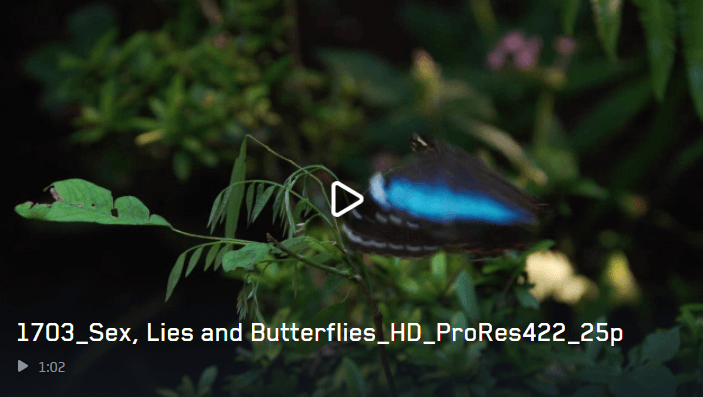




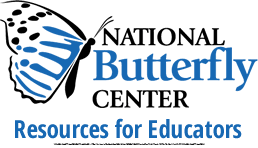



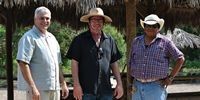
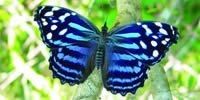
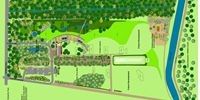
 Media
Media